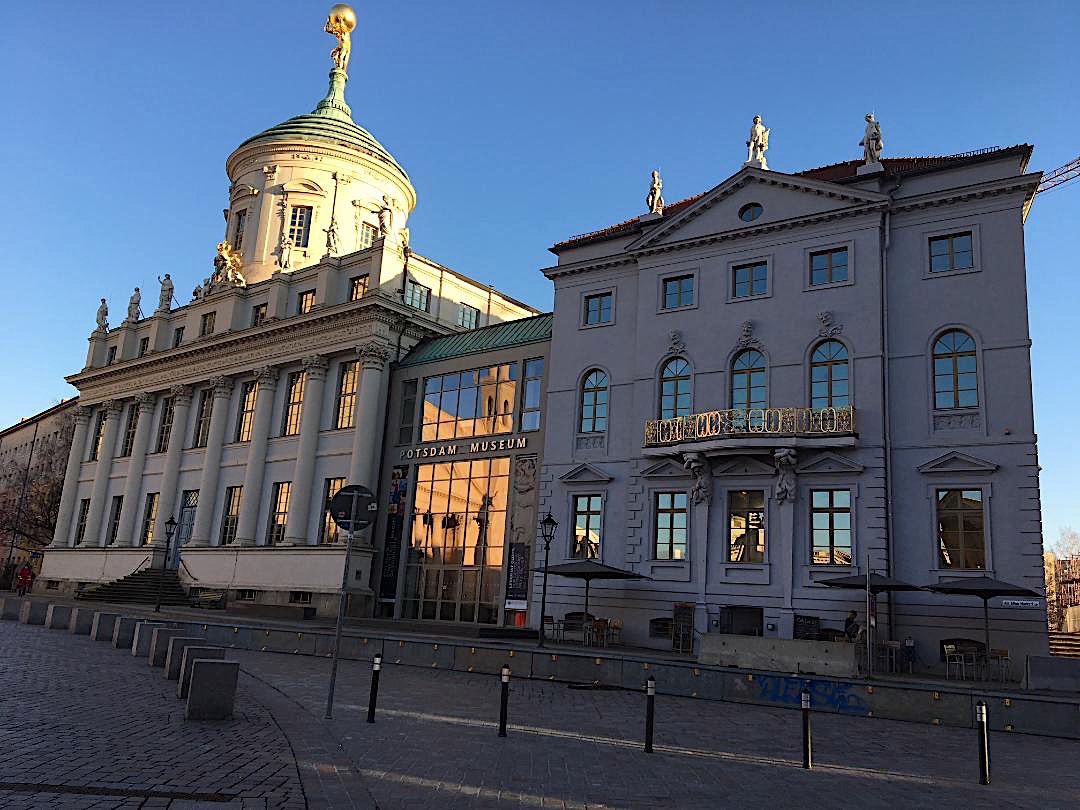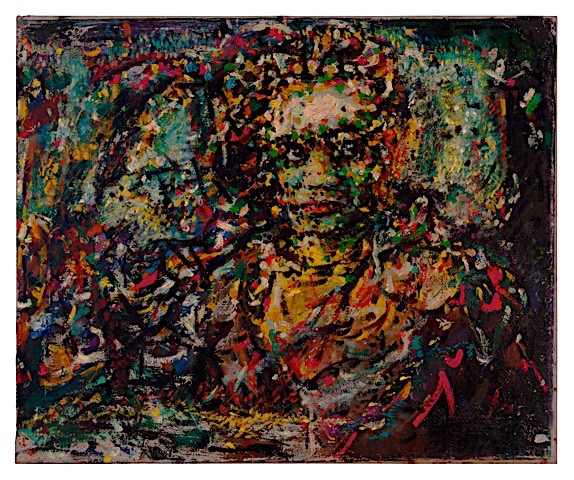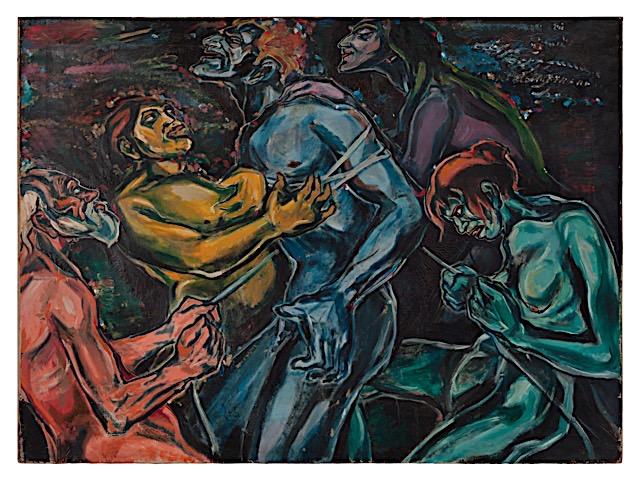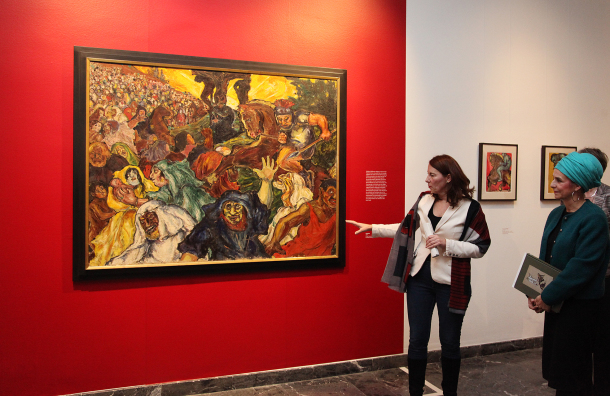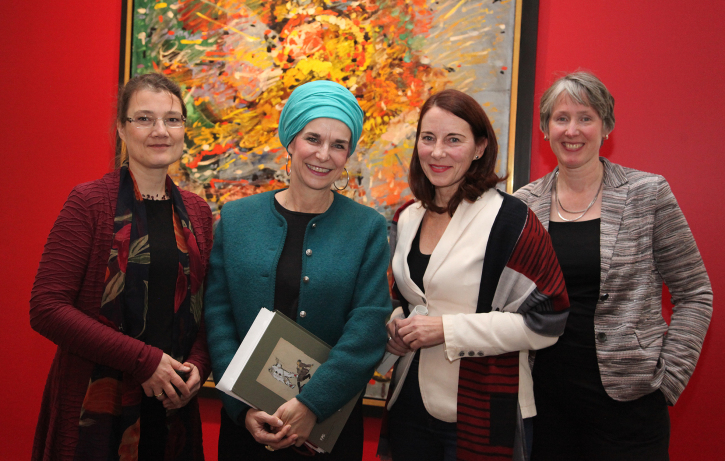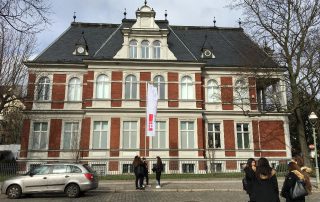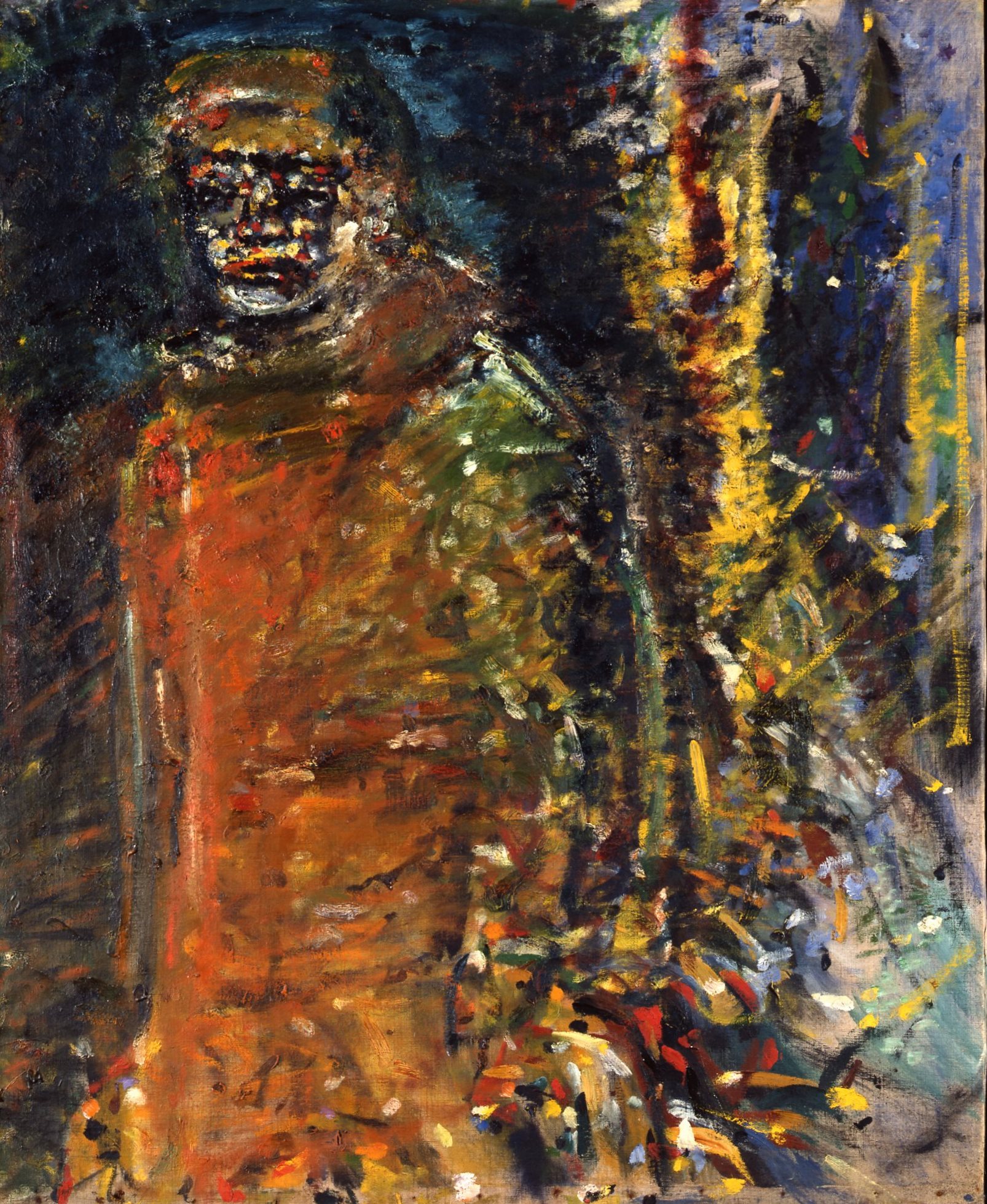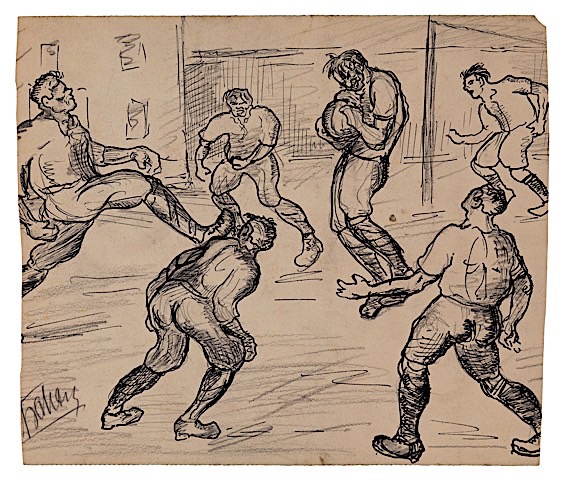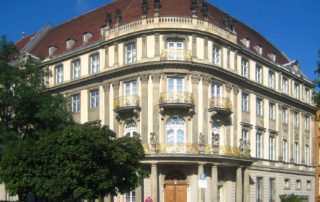Rachel Stern2020-11-29T20:32:16-05:00August 7th, 2020|Events, Past Events|
View a recording of the event HERE. Lecture featuring Aya Soika, Professor of Art History at Bard College Berlin, Germany Moderated by Rachel Stern, Executive Director of the Fritz Ascher Society in New York The German Expressionist Emil Nolde is arguably one of most prominent victims of the Nazis' art politics: No other painter had so many works confiscated, or was presented as prominently in the show „Degenerate Art,“ which opened in Munich in July 1937. Yet, his position differs fundamentally from that of many other artists who will be presented in the Fritz Ascher Society's lecture series "From Flight to Fight": Nolde was not just a victim but also a loyal supporter of the regime whose world views were radicalized by antisemitic propaganda in [...]
Rachel Stern2019-02-05T12:43:50-05:00October 12th, 2018|Exhibitions, Past Exhibitions|
The exhibition "Umkämpfte Wege der Moderne. Wilhelm Schmid und die Novembergruppe" is dedicated to the controversial epoch of 1918-1933 and the radical changes during the following period. (link) Some of the artistic pioneers took the 1918/1919 revolution as an opportunity to unite as the "November Group", probably the most prominent political artistic group of the Weimar Republic. These self-proclaimed "revolutionaries of the mind" set out on new paths of artistic expression with their motives, colors and forms, rejecting the old imperial conventions in form and content. The members of the group not only caused a sensation with their revolutionary demand to participate in the new state in all art-related issues. For in the exhibitions - primarily at the Great Berlin [...]
Rachel Stern2018-11-26T05:40:08-05:00September 4th, 2018|Newsletter|
Dear Friends, I know, this summer I seem obsessed with Fritz Ascher’s I know, this summer I seem obsessed with Fritz Ascher’s Dancers from 1921. But there is one more thought about the drawing that I want to share. Fritz Ascher, Dancers, 1921. Private collection. Photo Malcolm Varon ©2018 Bianca Stock Fritz Ascher, Dancers, 1921. Private collection. Photo Malcolm Varon ©2018 Bianca Stock When the drawing was created,“Freikörperkultur” (FKK) or “free body culture” had become popular in Germany. Founded in 1898 in Essen, Germany, the nudist culture was about celebrating the body unencumbered by clothes, in nature and sunlight. Many of the naturists came from the Wandervogel movement, the pre-eminent German youth movement, founded to escape the repressive and [...]
Rachel Stern2018-12-04T11:47:15-05:00March 23rd, 2018|Newsletter|
Dear Friends, I was touched by how many neighbors and friends from near and far came out into the chilly but sunny winter weather on February 21 to celebrate Fritz Ascher and recognize his persecution by the National Socialists by laying a “Stolperstein” (stumbling stone) at Niklasstraße 21/23 in Berlin-Zehlendorf, where his family lived from 1909. Thank you to the anonymous donor for making this event possible, to Dirk Jordan (AG Stolpersteine), Michael Rohrmann (Projekt Stolpersteine) and Wolfgang Ellerbrock for organizing it, to Cornelie von Bismarck for creating a beautiful context, and to Sabine Witt from Museum Charlottenburg-Wilmersdorf in Berlin and Jutta Götzmann from Potsdam Museum for supporting it. A special thank you to the students from Potsdam for reciting [...]
Rachel Stern2018-12-04T11:57:56-05:00December 27th, 2017|Select Press Coverage|
Fritz-Ascher-Retrospektive „Leben ist Glühn“ Die Wiederentdeckung des Expressionisten Fritz Ascher: eine Doppelausstellung in der Villa Oppenheim und im Potsdam Museum. by Elke Linda Buchholz Einen so vollständig vergessenen Künstler zurückzuholen in die Aufmerksamkeit, braucht Kraft, Geduld und kreative Energie. Vor 30 Jahren stieß die deutsch-amerikanische Kuratorin Rachel Stern bei einem Sammler auf Arbeiten von Fritz Ascher. Sie hatte noch nie von ihm gehört. Jetzt ist sie als quasi weltweit einzige Expertin für den 1893 geborenen Maler wieder zurück in der Stadt, wo auch er einst gelebt und gearbeitet hat. Hier bei Max Liebermann holte der junge Wilde sich als 16-Jähriger nach abgebrochener Schule die höheren Weihen einer Empfehlung an die Königsberger Kunstakademie und startete zwischen Secessionisten und Expressionisten seine Karriere. [...]
Rachel Stern2018-12-04T12:05:52-05:00December 26th, 2017|Select Press Coverage|
Der vergessene Expressionist Das Potsdam-Museum zeigt Werke des von den Nazis verfolgten Malers Fritz Ascher by Mathias Richter Sie gehören zur sogenannten verlorenen Generation. Künstler wie Gertrude Sandmann, Magda Langenstrass-Uhlig oder Eric Isenburger. Sie hatten Anfang der 30er Jahre grosse Ambitionen und wahrscheinlich eine grosse Karriere vor sich. Doch mit dem Machtantritt von Adolf Hitler erhielten sie Berufsverbot, wurden verfolgt, ihre Werke als "entartete Kunst" verfemt. Wer die Nazi-Zeit überlebte war vergessen und stand vor dem Nichts. Einer der Angehörigen dieser verlorenen Generation ist Fritz Ascher. Das Potsdam-Museum widmet dem radikalen Berliner Expressionisten in Kooperation mit der Villa Oppenheim in Berlin-Charlottenburg von Sonntag an eine Sonderausstellung. 80 Gemälde und Grafiken sind in den beiden Museen zu sehen, davon etwa 50 [...]
Rachel Stern2018-12-04T12:07:01-05:00December 25th, 2017|Select Press Coverage|
Ein Zerrissener Das Potsdam Museum entdeckt Fritz Ascher, der sich in Potsdam vor den Nazis versteckte by Lena Schneider Wer war Fritz Ascher? Das Potsdam Museum hat diesem Unbekannten eine Sonderausstellung gewidmet. „Leben ist glühn“ heißt sie. Ein Bild, das hier hängt, kann man als bestürzende Antwort auf die Frage lesen. „Bajazzo“ heißt es, nach dem italienischen Bruder des Harlekin. Zu sehen ist eine schemenhafte Gestalt, in gelbem Kostüm. Im weiß geschminkten Gesicht ist so etwas wie ein trostloser Schatten des Clownsgenres auszumachen: schwarze Augen, die rot überzogen Mundwinkel krümmen sich nach unten. Das ganze Bild ist wie zerschossen von Farbpunkten. Die Antwort darauf, wer Fritz Ascher, geboren 1893 als Kind jüdischer Eltern, war, findet sich im Entstehungsdatum des Bildes: [...]
Rachel Stern2018-12-04T12:14:23-05:00December 22nd, 2017|Newsletter|
Dear Friends, I am humbled and honored to have received the Lea and Hans Grundig Prize for my work about Fritz Ascher. Right on time for his 125th birthday, the Fritz Ascher retrospective is now open in Berlin and Potsdam, the two places where the artist lived and worked. Museum Charlottenburg-Wilmersdorf in der Villa Oppenheim in Berlin exhibits an overview of the artist’s creative development, with a focus on works that relate to Berlin. We see his sketch of the artist Max Liebermann as well as his love for music and performance in Weimar Republic paintings like “Beethoven” and “Bajazzo and Artists”. After surviving the Nazi terror regime in hiding in the Berlin Grunewald neighborhood, he painted these works over [...]
Rachel Stern2018-12-03T16:06:56-05:00December 8th, 2017|Exhibitions, Past Exhibitions|
Coming home: With more than 80 paintings and works on paper, the worldwide first Fritz Ascher Retrospective is on view at the places where Fritz Ascher lived and worked, with parallel exhibitions in Berlin and Potsdam. Each venue shows a representative group of powerful paintings and drawings, which span Ascher's whole oeuvre from first academic studies to monumental Expressionist figure compositions to late landscapes. Both venues present Fritz Ascher's poems, written while hiding from Nazi persecution, as "unpainted paintings" in relation to his artwork. In Berlin, Museum Charlottenburg-Wilmersdorf in der Villa Oppenheim shows an overview of the artist’s creative development, with a focus on works that relate to Berlin. We see his sketch of the artist Max Liebermann as [...]
Rachel Stern2018-12-04T12:27:33-05:00September 17th, 2017|Select Press Coverage|
Kunststück Wiebke Hölzer Die Masse stürmte um ihn her. / Starr, stumm, in sich blieb er versunken.« So beginnt das von dem Berliner Künstler Fritz Ascher verfasste Gedicht »Bajazzo«. Die Zeilen umschreiben treffend das Sichtbare auf seinem gleichnamigen Ölgemälde: Starr und wie in einem Sturm aus farbigen Pinselstrichen schreitet der Bajazzo, also die italienische Clownsfigur, nach links gewandt von einer abstrakt gehaltenen Umgebung ins Dunkel. Als erste Körperform nimmt der Betrachter den Kopf wahr, während der Rest des Körpers mit dem Hintergrund verschmilzt. Zwar reduziert Ascher die Mimik der Figur, aber gestaltet sie gleichzeitig ausdrucksstark - der Mund vermittelt das Gefühl von Traurigkeit und die Augen in Form schwarzer Höhlen symbolisieren als Spiegel der Seele das leere, einsame Innere. Die [...]
Rachel Stern2018-12-04T12:33:53-05:00July 10th, 2017|Newsletter|
Dear Friends, Time for the outdoors! What could be timelier than an exhibition about soccer. On July 26th, the Ephraim Palais in Berlin is opening “Hauptstadtfussball,” celebrating the 125th anniversary of the Berlin soccer club Herta BSC and its local rivals. In this exhibition, you can find Fritz Ascher’s “Soccer Players” from c. 1916! It will be on view until January 8, 2018: link Since the last newsletter, Wiebke Hölzer published two essays about Fritz Ascher, one in the Biographisch-Bibliografisches Kirchenlexikon (BBKL, vol. 38, Nordhausen 2017), and one called "Kunststück" examining his “Bajazzo” from 1924 in Weltkunst No. 129 from May 2017 (pp. 120-121). And our most accomplished lawyer, the author Nicholas O'Donnell, a veteran attorney and litigation partner at the [...]
Rachel Stern2018-12-03T16:06:57-05:00June 30th, 2017|Exhibitions, Past Exhibitions|
July 25th, 2017 is the 125th birthday of the Berlin soccer club Hertha BSC. This birthday is celebrated with a special exhibition at the museum Ephraim-Palais, which enables visitors to experience captivating chapters of Berlin sports- and city history. Today Herta is Number One among Berlin soccer clubs, followed by East Berlin's Union Berlin. But those who know the scene know that there are more than 400 soccer clubs in Berlin, with more that 150,000 members, as well as numerous soccer fields and pubs for fans. Fritz Ascher's drawing "Soccer Players" from c. 1916 is part of this exhibition. The artist portraits a dramatic scene: surrounded by four players the forward attacks from the left. His leg is still up [...]



